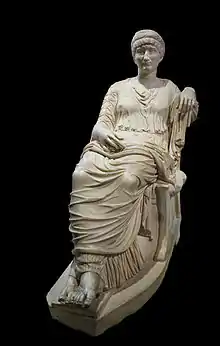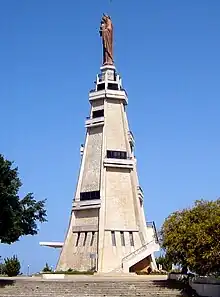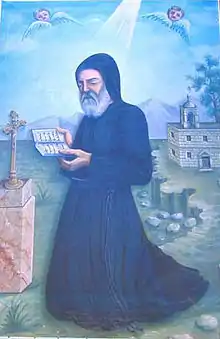| Key event(s): |
 Colossus of Constantine, whose reign is attributed to numerous changes that have permanently affected the course of Western history.[1] |
| Chronology: |
|
| History of Lebanon |
|---|
 |
| Timeline |
|
|
This article lists historical events that occurred between 301–400 in modern-day Lebanon or regarding its people.
Administration
_-_Foto_G._Dall'Orto_28-5-2006_(cropped).jpg.webp)
Diocletian (r. 284–305) separated the district of Batanaea and gave it to Arabia, while sometime before 328, when it is mentioned in the Laterculus Veronensis, Constantine the Great (r. 306–337) created the new province of Augusta Libanensis (lit. 'Lebanese Augusta') out of the eastern half of the old province of Phoenice, encompassing the territory east of Mount Lebanon.[2]
Governors
In the fourth century, as a whole, almost 30 governors of Phoenicia are known with 23 governors of Phoenicia being in office between 353 and 394.[3] Amongst them was Sossianus Hierocles, who was a praeses at some time between 293 and 303.[4] The Prosopography of the Later Roman Empire (PLRE) states that, as praeses, he governed Phoenice Libanensis,[5] the province on the eastern side of Mount Lebanon. The district included Palmyra, where the inscription attesting to Hierocles' career is located.[6]
Consularis Governors of Phoenicia
| Consularis Governor | Date |
|---|---|
| Aelius Statuus | Between 293 and 305 |
| Sossianus Hierocles | Between 293 and 303 |
| Julius Julianus | Before 305 |
| Maximus | ? Between 309/313 |
| Achillius | c. 323 |
| Fl. Dionysius | 328 – 329 |
| Archelaus | 335 |
| Nonnus | c. 337 |
| Marcellinus | 342 |
| Apollinaris | 353/4 |
| Demetrius | Before 358 |
| Nicentius[7] | 358 – 359 |
| Euchrostius | (?) 359/60 |
| Julianus | Before 360 |
| Andronicus | 360 – 361 |
| Aelius Claudius Dulcitius | Before 361 |
| Anatolius | 361 |
| Polycles | c. 361/2 |
| Julianus | 362 |
| Gaianus | 362 – 363 |
| Marius | 363 – 364 |
| Ulpianus | 364 |
| Domninus | 364 – 365 |
| Leontius | 372 |
| Petrus | 380 |
| Proculus | 382 – 383 |
| Eustathius | Before 388 |
| Antherius | 388 |
| Epiphanius | 388 |
| Domitius | 390 |
| Severianus | 391 |
| Leontius | 392 |
Events
300s

- The Edict on Maximum Prices is issued by the emperor Diocletian in 301 AD, with the prices and simulated sailing times from Nicomedia to Beirut reported to be 12 denarii for 9.9 days of duration with the ratio (price/duration) being 0.83.[8]
- Beginning of the Diocletianic Persecutions, 303 AD.[9]
- Five young Christians are martyred at Tyre in 303.[10]
- Ulphianus, a Tyrian youth, is martyred, 303 AD.[11]
- 500 Christians in Tyre get tortured and martyred in 304 AD.[12]
- Aphian, a student of the Law school of Berytus, is martyred on April 2 c. 305 AD.[13][14]
 Porphyry, a detail of the Tree of Jesse, 1535, Sucevița Monastery.
Porphyry, a detail of the Tree of Jesse, 1535, Sucevița Monastery. - The Tyrian-born Porphyry (philosopher) dies in c. 305 AD.[15]
- Constantine is emperor on 25 July 306.
- The Governor Urbanus, shortly after Easter 307, orders the virgin Theodosia of Tyre to be thrown to the sea for conversing with Christians attending trial and refusing sacrifice.[16]
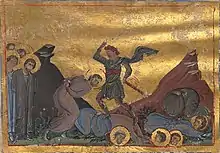
- Maximus is consularis (governor) of Phoenice, c. 309 AD.
- Pamphilus of Caesarea, a biblical scholar from a rich and honorable family of Beirut, is martyred in February 16, 309.[17][18]
310s
- Tyrannion of Tyre is martyred during the Diocletianic Persecutions, 311 AD.[10]
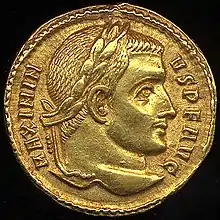
- Maximinus issues a rescript encouraging every city to expel its Christians. This rescript is published in Tyre on May or June, 312 AD.[19]
- Emperor Constantine converts to Christianity in 312 AD.
- The Edict of Milan, is issued in February of 313 AD.
- In 315 AD, the cathedral of Paulinus in Tyre is inaugurated by the Bishop Eusebius, who recorded his speech and thus a detailed account of the site in his writings.[20]
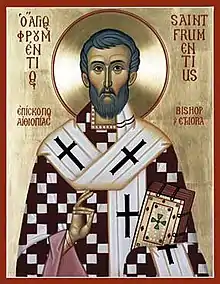
- In 316, the Tyrian-born Frumentius and his brother, Edesius accompanied their uncle Metropius on a trip to the Kingdom of Axum by ship, the crew was massacred in a port on the Red Sea and the boys taken as slaves to the King of Axum. Frumentius and Edesius, who were both christian, gained favor with the king and his family, signaling the birth of Christianity in Ethiopia.[21]
320s
- Achillius is consularis of Phoenice c. 323 AD.
- During the reign of Emperor Constantine, his mother, Helena of Constantinople, requests in 324 the destruction of all pagan temples and idols dedicated to Astarte. The Astarte shrine in Maghdouché was probably destroyed at that time and converted to a place of devotion to Mary.[22]
- Paulinus of Tyre is the Patriarch of Antioch and all the East for about six months in 324 and 325.[23]
- The First Council of Nicaea – in which ten bishops from Phoenicia attended (one of them being Zeno I, bishop of Tyre) – is convened in 325 AD.[24][25]
330s

- Archelaus is consularis of Phoenice 335 AD.
- The First Synod of Tyre or the Council of Tyre (335 AD), a gathering of bishops, in which the first historically documented bishop of Tripoli, Hellanicus,[27] took part, for the primary purpose of evaluating charges brought against Athanasius, the Patriarch of Alexandria, is called together by Emperor Constantine.[28]
- Emperor Constantine is baptized by the once-bishop of Beirut, Eusebius of Nicomedia, right before his death on 22 May 337.
- Nonnus is consularis of Phoenice c. 337 AD.
340s
350s
- Apollinaris is consularis of Phoenice, 353/4.
- The Letter 492 of Rhetorician Libanius to Vindonius Anatolius of Beirut is written in 356, in the letter, Libanius writes that Anatolius, a native of Phoenicia, had spent some time “among us”, (i.e. in Antioch).[30]
- In about 356, the Emperor Constantius II writes to Axumite King Ezana and his brother Saizana, requesting them to replace Frumentius as bishop with Theophilos the Indian, who supported the Arian position, as did the emperor. The king refused the request.[31][32]
- Nicentius is consularis of Phoenice 358 – 359
- Euchrostius is consularis of Phoenice 359/60
360s
- In 360, Dominus the Elder, a law school professor, declines the invitation of Libanius to leave the Law School at Beirut and to teach with him at the rhetoric school of Antioch.[33]
- Andronicus is consularis of Phoenice, 360 – 361.
- Anatolius is consularis of Phoenice, 361 AD.
- Polycles is consularis of Phoenice, c. 361/2 AD.
- Julianus is consularis of Phoenice, 362 AD.
.jpg.webp)
- Around 362 AD, Julian the Apostate burns a basilica that existed in Beirut.[34]
- The 107-year-old Dorotheus of Tyre, bishop of Tyre, is martyred in 362 AD.[35]
- Gaianus of Tyre is the consular governor of Phoenicia in 362.
- Marius is consularis of Phoenice, 363 – 364.
- Ulpianus is consularis of Phoenice, 364.
- Domninus is consularis of Phoenice, 364 – 365.
- In 365 AD, Tyre and Sidon alongside several other coastal cities are damaged by a tsunami caused by the Crete earthquake.[36]
370s
- Leontius is consularis of Phoenice, 372 AD.
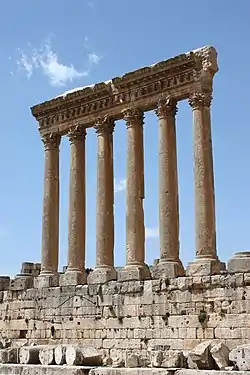
- The Temple of Jupiter at Baalbek, already greatly damaged by earthquakes,[37] is demolished under Theodosius in 379 and replaced by another basilica (now lost), using stones scavenged from the pagan complex.[38]
380s
- Petrus is consularis of Phoenice, 380 AD.
- The Edict of Thessalonica is issued on 27 February AD 380, making Christianity the sole official religion of the Roman empire.
- Diodorus is bishop of Tyre, 381 AD.[39]
- Proculus is consularis of Phoenice, 382 – 383.
- Frumentius dies c. 383.

- Proculus, governor of Phoenicia, is Comes Orientis between 383 and 384. During this time, his name was carved on the Commemorative stela of Nahr el-Kalb.[40]
- Antherius and Epiphanius are cōnsulārēs of Phoenice, 388 AD.
390s
- Domitius is consularis of Phoenice, 390.
- Severianus is consularis of Phoenice, 391.
- Leontius is consularis of Phoenice, 392.
Education
In the 4th century, the Greek rhetorician Libanius reported that the school attracted young students from affluent families and deplored the school's instructional use of Latin, which was gradually abandoned in favor of Greek in the course of the century.[41][42][43][44]
Historically, Roman stationes or auditoria, where teaching was done, stood next to public libraries housed in temples. This arrangement was copied in the Roman colony at Beirut. The first mention of the school's premises dates to 350.[45]
Professors
| Dates[46] | Names
(uncertain names in italic) |
| Summer 356 to March / April 364 | Domninus (Domnio) |
| October 363 | Scylacius |
| Summer 365 | Anonymous |
| Summer 388 | Sebastianus? |
Architecture
- Shrine of Our Lady of Nourieh.
- Our Lady of Awaiting, Maghdouché.
- A basilica in Tyre built upon the ruins of a church by the city's bishop, Paulinus.[47]
References
- ↑ Norwich, John Julius (1996). Byzantium (First American ed.). New York. pp. 54–57.
- ↑ Eißfeldt 1941, pp. 368–369.
- ↑ A.H.M. Jones, J.R. Martindale, J. Morris, Prosopography of the Later Roman Empire, vol. I: AD 260–395, Cambridge 1971 (hereinafter: PLRE I), pp. 1105–1110 (fasti). For the reviews, often negative, and corrections to the first volume of PLRE, cf. A.H.M. Jones, “Fifteen years of Late Roman Prosopography in the West” (1981–95), [in:] Medieval Prosopography 17/1, 1996, pp. 263–274.
- ↑ CIL III, 133; Prosopography of the Later Roman Empire 1.432 s.v. "Sossianvs Hierocles 4", citing L'Année épigraphique 1932, 79 = Supplementum Epigraphicum Graecum 7.152.
- ↑ Prosopography of the Later Roman Empire 1.432 s.v. "Sossianvs Hierocles 4".
- ↑ Simmons, 848.
- ↑ Martindale, J. R. & A. H. M. Jones, "Nicentius 1", The Prosopography of the Later Roman Empire, Vol. I AD 260-395 (Cambridge: University Press, 1971), p. 628
- ↑ Princeton/Stanford Working Papers in Classics, Explaining the maritime freight charges in Diocletian’s Price Edict, Version 1.0, April 2013, Walter Scheidel, Stanford University.
- ↑ Philip F. Esler, ed. (2000). The Early Christian World, Vol.2. Routledge. pp. 827–829. ISBN 978-0-415-16497-9.
- 1 2 Basil Watkins, The Book of Saints, 8th ed. (Bloomsbury, 2016 [1921]), p. 734.
- ↑ Baring-Gould, S. (Sabine) (1897). The Lives Of The Saints: Volume 04, April. London, J. C. Nimmo.
- ↑ "500 Martyrs of Tyre". Living Maronite. 2017-02-19. Retrieved 2022-09-17.
- ↑ Saints of April 2: Amphianus
- ↑ Campbell, Thomas Joseph (1907). . Catholic Encyclopedia. Vol. 1.
- ↑ Schott, Jeremy M. (2013-04-23). Christianity, Empire, and the Making of Religion in Late Antiquity. University of Pennsylvania Press. ISBN 978-0-8122-0346-2.
- ↑ Eusebius, De Martyribus Palestinae 7.1f, cited in Barnes, Constantine and Eusebius, 152.
- ↑ "Henry Wace: Dictionary of Christian Biography and Literature to the End of the Sixth Century A.D., with an Account of the Principal Sects and Heresies. - Christian Classics Ethereal Library". www.ccel.org. Retrieved 2022-09-17.
- ↑ Christa Müller-Kessler, The Unknown Martyrdom of Patriklos of Caesarea in Christian Palestinian Aramaic from St Catherine’s Monastery (Sinai, Arabic NF 66), Analecta Bollandiana 137, 2019, pp. 63-71
- ↑ Eusebius, De Martyribus Palestinae 4.8; Barnes, Constantine and Eusebius, 152; Keresztes, 384; Mitchell, p. 117.
- ↑ Medlej, Youmna Jazzar; Medlej, Joumana (2010). Tyre and its history. Beirut: Anis Commercial Printing Press s.a.l. pp. 1–30. ISBN 978-9953-0-1849-2.
- ↑ RUFINUS, Historia Ecclesiastica, lib. I, cap. ix, in P.L., XXI, 478-80; Acta SS. Oct., XII, 257-70; DUCHESNE, Les missiones chrétienne au Sud de l'empire romain in Mélanges d'archéologie et d'histoire (Rome, 1896), XVI, 79-122; THEBAUD, The Church and the Gentile World (New York, 1878), I, 231-40; BUTLER, Lives of the Saints, 27 Oct.; BARING-GOULD, Lives of the Saints (London, 1872), 27 Oct.
- ↑ maghdouche.pipop.org
- ↑ Sozomen, H. E. I. 17, Theodoret, H. E. I. 7, and the Acts of the Council of Nicæa, ed. Labbei et Cossartii, I. p. 51
- ↑ Hitti, Philip K. (1951) History of Syria including Lebanon and Palestine. New York: The Macmillan Company. p. 363 fn.
- ↑ Cowper, B. H. (1861). Syriac Miscellanies. London:Williams and Norgate. pp. 9–10. Preterist Archive website Archived 2018-10-07 at the Wayback Machine Retrieved 2 April 2018.
- ↑ Biographical notes: PLRE I, p. 259 [s.v. Flavius Dionysis 11].
- ↑ Le Quien, Oriens christianus
- ↑ Encyclopedia Americana, vol. 2 Danbury, Connecticut: Grolier Incorporated, 1997. ISBN 0-7172-0129-5.
- ↑ PLRE I 545; 546.
- ↑ Libanius, Ep. 492, 2: σὺ γὰρ δὴ Φοίνιξ ὢν καὶ διατρίβων τὰ μὲν ἐκεῖ, τὰ δὲ παρ’ ἡμῖν.
- ↑ "Letter of Constantius to the Ethiopians against Frumentius", Bible Suite, Christian Booksheld
- ↑ "Frumentius of Axum", Blackwell Reference Online
- ↑ Collinet 1925, p. 121
- ↑ Kassir (2002); Kassir, S. Histoire de Beyrouth, Ed. Fayard, Paris p.51, 2003.
- ↑ "Saint Dorotheus of Tyre". Saints.SQPN. Retrieved April 5, 2011.
- ↑ "Ammianus Marcellinus on the tsunami of 365 - Livius". www.livius.org. Retrieved 2022-09-23.
- ↑ Cook (1914), p. 556.
- ↑ Cook (1914), p. 555.
- ↑ "Nicene and Post-Nicene Fathers, Ser. II, Vol. IV: Letters of Athanasius with Two Ancient Chronicles of His Life.: To Diodorus (fragment). | St-Takla.org". st-takla.org. Retrieved 2022-09-17.
- ↑ Commemorative stela of Nahr el-Kalb at Livius.org
- ↑ Collinet 1925, p. 39
- ↑ Clark 2011, p. 36
- ↑ Sadowski 2010 pp. 211–216
- ↑ Rochette 1997 pp. 168, 174
- ↑ Collinet 1925, p. 62
- ↑ Collinet 1925, p. 192
- ↑ Doig, Allan (2008). Liturgy and architecture from the early church to the Middle Ages. Internet Archive. Aldershot, England ; Burlington, VT : Ashgate. ISBN 978-0-7546-5272-4.
Sources
- Linda Jones Hall, Roman Berytus: Beirut in late antiquity (2004)
- Attridge, Harold W.; Gōhei Hata (1992). Eusebius, Christianity, and Judaism. Detroit: Wayne State University Press. ISBN 978-0-8143-2361-8.
- Kassir, Samir; M. B. DeBevoise (2010). Beirut. Berkeley: University of California Press. ISBN 978-0-520-25668-2.
- Sadowski, Piotr (2010). "Szkoła prawa w Bejrucie w świetle listów i mów Libaniusza" [Beirut law school in the light of letters and sayings of Libanius] (PDF). Studia Prawnoustrojowe (in Polish). 12: 203–218. Archived from the original (PDF) on 2019-08-27 – via Czasopisma humanistyczne.
- Clark, Gillian (2011). Late Antiquity: A Very Short Introduction. New York: Oxford University Press. ISBN 978-0-19-161140-7.
- Collinet, Paul (1925). Histoire de l'école de droit de Beyrouth (in French). Paris: Société Anonyme du Recueil Sirey.
- Cook, Arthur Bernard (1914). Zeus: A Study in Ancient Religion. Vol. I: Zeus God of the Bright Sky. Cambridge: Cambridge University Press.
- Eißfeldt, Otto (1941). "Phoiniker (Phoinike)". Realencyclopädie der Classischen Altertumswissenschaft. Vol. Band XX, Halbband 39, Philon–Pignus. pp. 350–379.
- Simmons, Michael Bland. "Graeco-Roman Philosophical Opposition". In The Early Christian World, edited by Philip Francis Esler, 2.840–868. New York: Routledge, 2000.
